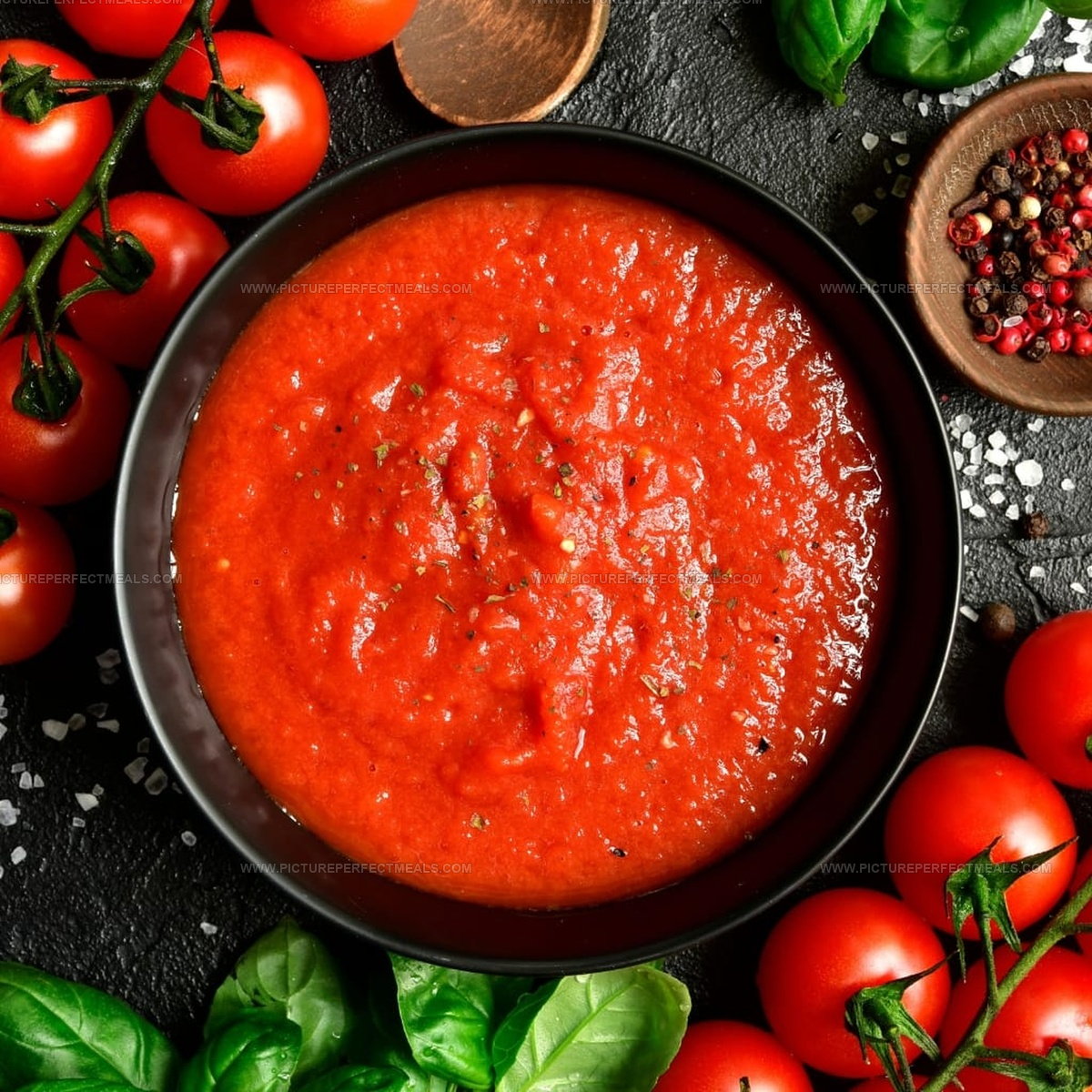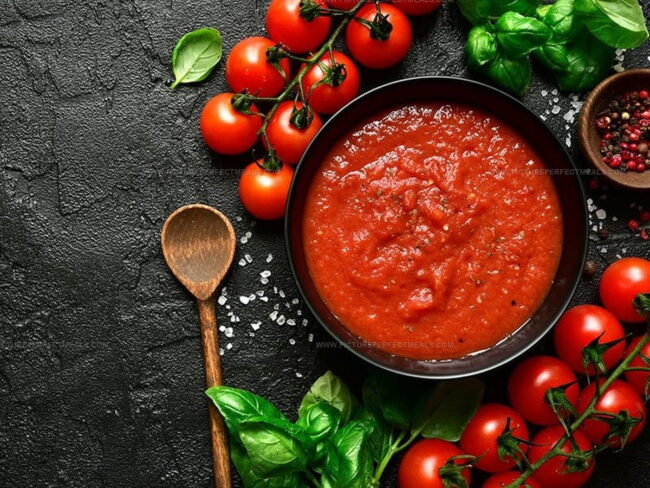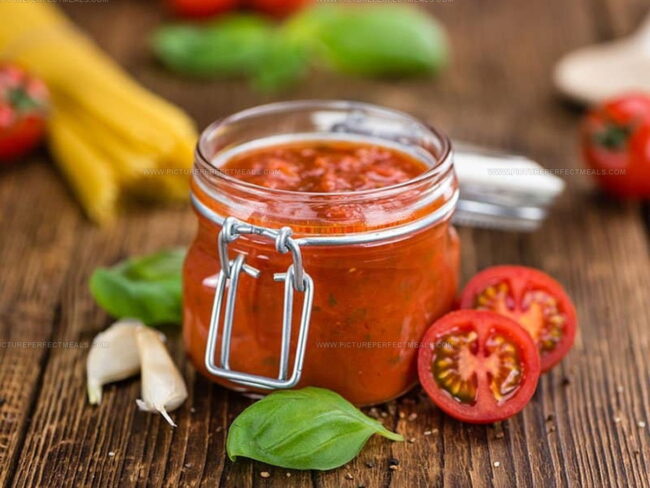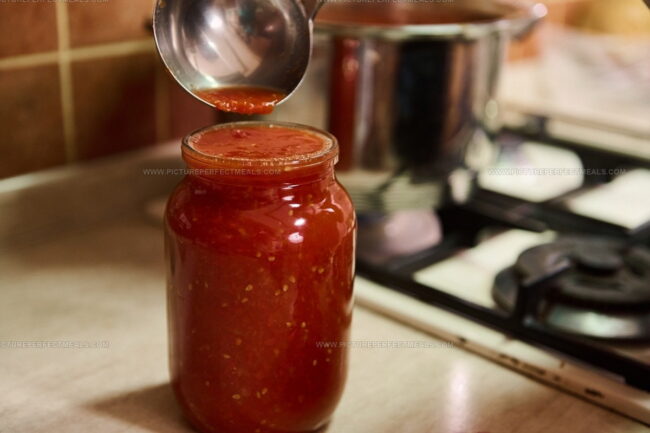7 Rich Tomato Alternatives Every Chef Should Have in the Pantry
Tomato passata is a smooth, strained tomato purée essential in many Italian recipes, yet it can sometimes be missing.
Several alternatives like crushed tomatoes, tomato puree, or even fresh blended tomatoes provide similar consistency and flavor.
Each substitute may require adjustments to seasoning or cooking times for best results.
This guide highlights seven tomato passata replacements that keep your sauces vibrant and rich.
Knowing how to tweak texture and acidity ensures your dishes stay true to tradition.
With these options, you can continue crafting authentic meals without a trip to specialty stores.
Discover versatile solutions for your next Italian culinary adventure.
Tomato Passata’s Key Qualities
Tomato passata is prized for its smooth, vibrant texture and fresh, pure tomato flavor, making it a versatile base in many dishes. Unlike chunkier sauces, passata is finely strained to remove seeds and skins, resulting in a velvety consistency that blends seamlessly into recipes.
It offers a bright, natural sweetness balanced by subtle acidity, which enhances sauces, soups, and stews.
Typically uncooked, passata maintains the fresh essence of ripe tomatoes, providing a clean and vibrant taste for creating authentic Italian dishes and beyond.
Must-Try Alternatives for Tomato Passata
Tomato passata substitutes keep sauces smooth, rich, and flavorful with different pureed tomato products. Many provide excellent texture and taste. See which alternatives could enhance your cooking.
Canned Tomatoes
Passata substitution starts with canned tomatoes, which stand as the best alternative despite being cooked rather than raw like traditional passata.
These canned options actually preserve that delicious tomato flavor quite well, making them perfect for most recipes.
The texture might differ slightly depending on whether you choose whole, chopped, or crushed varieties, but this is easily addressed by mashing and straining whole tomatoes if needed.
Canned alternatives typically create a thinner consistency in your dishes, so simmering a few extra minutes helps achieve that perfect thickness.
Many people find this substitution so effective they barely notice the difference in their finished meals.
Pasta Sauce or Marinara Sauce
Passata substitutes are remarkably easy to find in most kitchens, with tomato pasta sauce or marinara sauce standing out as the top alternatives when you need that rich tomato flavor.
These sauces contain additional seasonings and spices that pure passata doesn't have, creating a slightly more complex flavor profile in your final dish.
The extra herbs and garlic in marinara sauce actually enhance many recipes that traditionally call for passata, especially in Italian-American cooking.
Regular pasta sauce works wonderfully in lasagnas, casseroles, and pizza bases where the additional flavors blend seamlessly with other ingredients.
Any sauce thickness differences can be adjusted with a little water to thin or extra simmering time to thicken, making these substitutes truly foolproof options for home cooks.
Tomato Paste
Tomato paste stands as the most reliable replacement for passata in your kitchen arsenal because of its pure tomato composition, just with a thicker texture.
By mixing in some water, you can easily adjust its consistency to match passata perfectly for any recipe on your list.
The authentic tomato flavor remains intact, making this substitution nearly impossible for anyone to detect in your finished dishes.
For cases where the thinned paste seems too runny, a simple blend of tomato paste with flour, sugar, and water creates an ideal passata-like consistency.
This quick homemade mixture works beautifully in pasta sauces, soups, or any dish calling for passata without compromising on taste or quality.
Fresh Tomatoes
Passata's standout quality is its fresh tomato flavor, making fresh tomatoes themselves an excellent substitute when you need that vibrant taste in your cooking.
With some extra effort, you can create a similar consistency by mashing tomatoes and straining out the seeds and skin, though this preparation does require more time than simply opening a jar.
The natural sweetness and acidity of fresh tomatoes will enhance your dishes in ways that processed alternatives cannot match.
Most recipes calling for passata will work beautifully with this substitute, just expect a slightly different texture unless you puree them thoroughly.
For busy weeknight cooking, this might not be the quickest option, but the superior flavor is often worth the additional minutes spent in preparation.
Pureed Red Peppers
Substituting tomatoes with pureed red peppers can save your recipe when the main ingredient isn't available.
Red peppers maintain the vibrant color of dishes while adding their own unique flavor profile that complements many recipes beautifully.
For an extra tang similar to passata, a splash of lemon juice mixed with the pepper puree creates a remarkably close match to tomato flavor.
Canned roasted red peppers from stores work perfectly in a pinch, though home-roasted peppers offer a deeper, more complex taste that many cooks prefer.
The process is quite straightforward- simply roast the peppers until their skins blacken, peel them once cooled, then blend them in a food processor until smooth for an excellent tomato alternative that works in sauces, soups, and many other dishes.
Ketchup
Substituting ketchup for passata isn't ideal since ketchup's sweetness can overpower your dish despite both being tomato-based.
Some cooks try diluting ketchup with water or adding vinegar to reduce sweetness, but this creates a thin, watery sauce that lacks passata's rich texture.
The additional ingredients in ketchup, including sugar and various spices, will significantly change your recipe's intended flavor profile.
For better results, crushed tomatoes or tomato purée make much closer alternatives to passata when cooking Italian dishes.
Most chefs recommend avoiding this swap entirely unless absolutely necessary, as the flavor compromise rarely justifies the convenience.
Meat Broth
Substituting passata with meat broth can bring that desired umami zing to your dishes when tomatoes aren't an option.
This savory alternative adds a deep, rich flavor profile that complements many recipes just as passata would.
The main difference lies in consistency, as broth lacks the thickness that passata naturally provides in sauces and soups.
Color variations will also be noticeable since the vibrant red tone from tomatoes won't be present in your final dish.
For best results, you might need to add a thickening agent like cornstarch or reduce the broth to achieve a similar texture in your cooking.
Despite these small adjustments, meat broth remains an excellent stand-in when you're looking for that complex, satisfying taste in tomato-free cooking.
Criteria for a Great Substitute of Tomato Passata
Finding the right substitute for tomato passata means looking beyond just tomatoes. Let’s explore the key qualities that make an alternative work perfectly.
Matching Viscosity and Mouthfeel
A good tomato passata substitute should closely replicate its smooth, thick texture without any chunks or seeds. The mouthfeel needs to be velvety and consistent to ensure it blends well into sauces and soups, providing that signature richness and body that passata offers.
Too thin a substitute can dilute recipes, while too thick might alter cooking times and final textures.
Balancing Acidity and Sweetness
Tomato passata strikes a natural balance between bright acidity and gentle sweetness, which is crucial for flavor harmony in dishes.
An ideal substitute must maintain this balance to avoid overwhelming the dish with sourness or cloying sweetness. This helps preserve the fresh tomato essence that passata brings, ensuring the overall taste remains authentic and well-rounded.
Neutral or Complementary Flavor Profile
Since tomato passata serves as a foundational ingredient, its flavor should be neutral enough to support a wide range of seasonings and ingredients.
A great substitute should either have a mild flavor or one that complements common recipe components without introducing overpowering or conflicting tastes.
Shelf-Stability and Ease of Preparation
Practicality matters; an effective substitute should be easy to find or make, with good shelf stability for convenience.
Whether it’s canned, jarred, or homemade, the alternative should store well without rapid spoilage and require minimal prep to save time in the kitchen.
DIY Passata from Fresh Tomatoes
Making your own tomato passata from fresh tomatoes is a rewarding way to capture the pure, vibrant flavor of ripe tomatoes, especially when they’re in season. The process involves a few straightforward steps that transform fresh tomatoes into a smooth, versatile sauce base you can use in countless recipes.
Choosing Tomatoes
Start with ripe, flavorful tomatoes; plum or Roma varieties work best due to their dense flesh and lower water content. These tomatoes yield a richer, thicker passata without needing excessive cooking to reduce liquid.
Preparing the Tomatoes
Begin by washing the tomatoes thoroughly. To remove the skins easily, score a small ‘X’ on the bottom of each tomato and briefly blanch them in boiling water for 30-60 seconds. Immediately transfer them to an ice bath to halt cooking and loosen the skins.
The skins should peel off effortlessly with your fingers or a small knife.
Removing Seeds and Processing
Once peeled, cut the tomatoes into quarters and remove the seeds if desired for an even smoother result.
Then, pass the tomatoes through a food mill or use a fine mesh sieve to crush and strain them, extracting the juice and pulp while leaving behind any remaining seeds and skin bits.
This step is crucial to achieving the silky texture characteristic of passata.
Cooking or Using Raw
Traditionally, passata is uncooked and stored fresh or frozen to preserve the bright tomato flavor. However, you can simmer it gently for a few minutes to thicken and intensify the taste if preferred.
Avoid boiling vigorously, as this can alter the fresh flavor.





Jenna Hartley
Founder & Recipe Creator
Expertise
Education
Box Hill Institute, Melbourne
William Angliss Institute, Melbourne
Jenna is the heart of Picture Perfect Meals, turning simple ingredients into beautiful, easy‑to‑make dishes.
Growing up around family meals in Melbourne, she trained at Box Hill Institute and then perfected her pastry skills at William Angliss Institute. She loves mixing classic Australian flavors with fresh ideas to keep cooking fun and stress‑free.